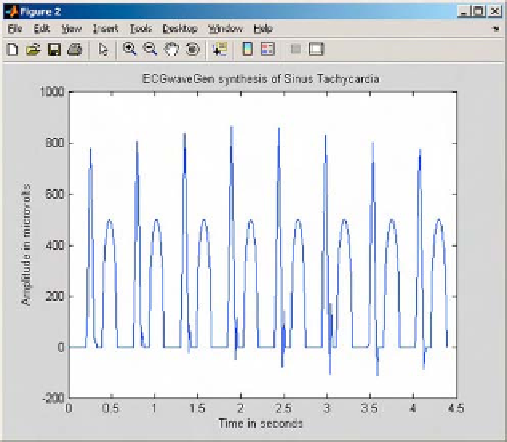Biomedical Engineering Reference
In-Depth Information
Figure 2.2-2 Simulation of sinus tachycardia.
Figure 2.2-3 Normal sinus rhythm generated using
ecgsyn
.
Unfortunately, the ECGwaveGen script available at
PhysioNet will not generate sinus tachycardia greater
than 110 bpm. There is a second script at PhysioNet
called ecgsyn. This script, based on the work of
McSharry et al. (2003), allows the user to have more
control over the morphology and frequency content.
ecgsyn is a simulation of three coupled differential
equations. The ecgsyn.m MATLAB script may be
downloaded
from
http://www.physionet.org/physi-
otools/ecgsyn/
.
With no arguments, the ecgsyn script will /generate
synthetic ecg with the following parameters:
ECG sampled at 256 Hz
Approximate number of heart beats: 256
Measurement noise amplitude: 0
Heart rate mean: 60 bpm
Heart rate std: 1 bpm
LF/HF ratio: 0.5
Internal sampling frequency: 512
Figure 2.2-4 Tachycardia generated using
ecgsyn
.
To generate sinus rhythm of 10 beats sampled at 64 Hz
with no noise:
s
¼
ecgsyn(64, 10, 0, 60);
There are roughly twice the number of PQRST com-
plexes in
Fig. 2.2-4
as there are in the same interval of
time in
Fig. 2.2-3
Synthesized ECG is not meant to be realistic, as it is
normally used to test biomedical instruments, using an
ECG-like signal with well-defined characteristics. Nev-
ertheless, the difference between the two simulators is
obvious by visually comparing their output: the ecgsyn
output is much more realistic, as it includes the P waves
and an S-T depression. The trade-off is obvious: a more
realistic simulation is required for solving a system of
three differential equations rather than a simulation
Since the ECG is sampled at 64 Hz, the first 256 samples
would cover 4 complexes (see
Fig. 2.2-3
).
plot (s(1:256))
The fourth argument is changed to vary the heart rate. To
simulate tachycardia using ecgsyn:
s
¼
ecgsyn(64,16, 0, 110);
and display the first 256 samples as before (
Fig. 2.2-4
).
plot(s (1:256)








